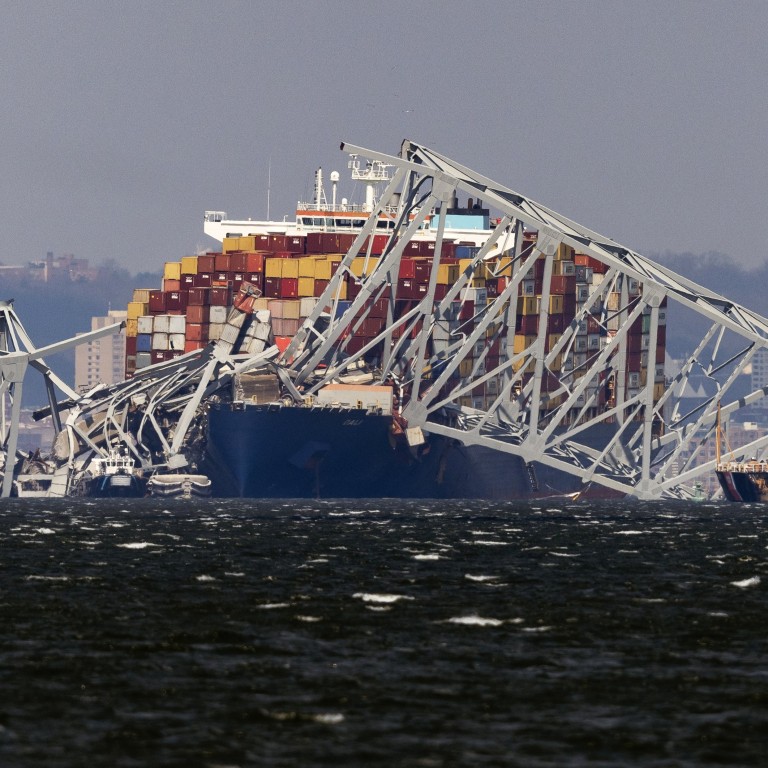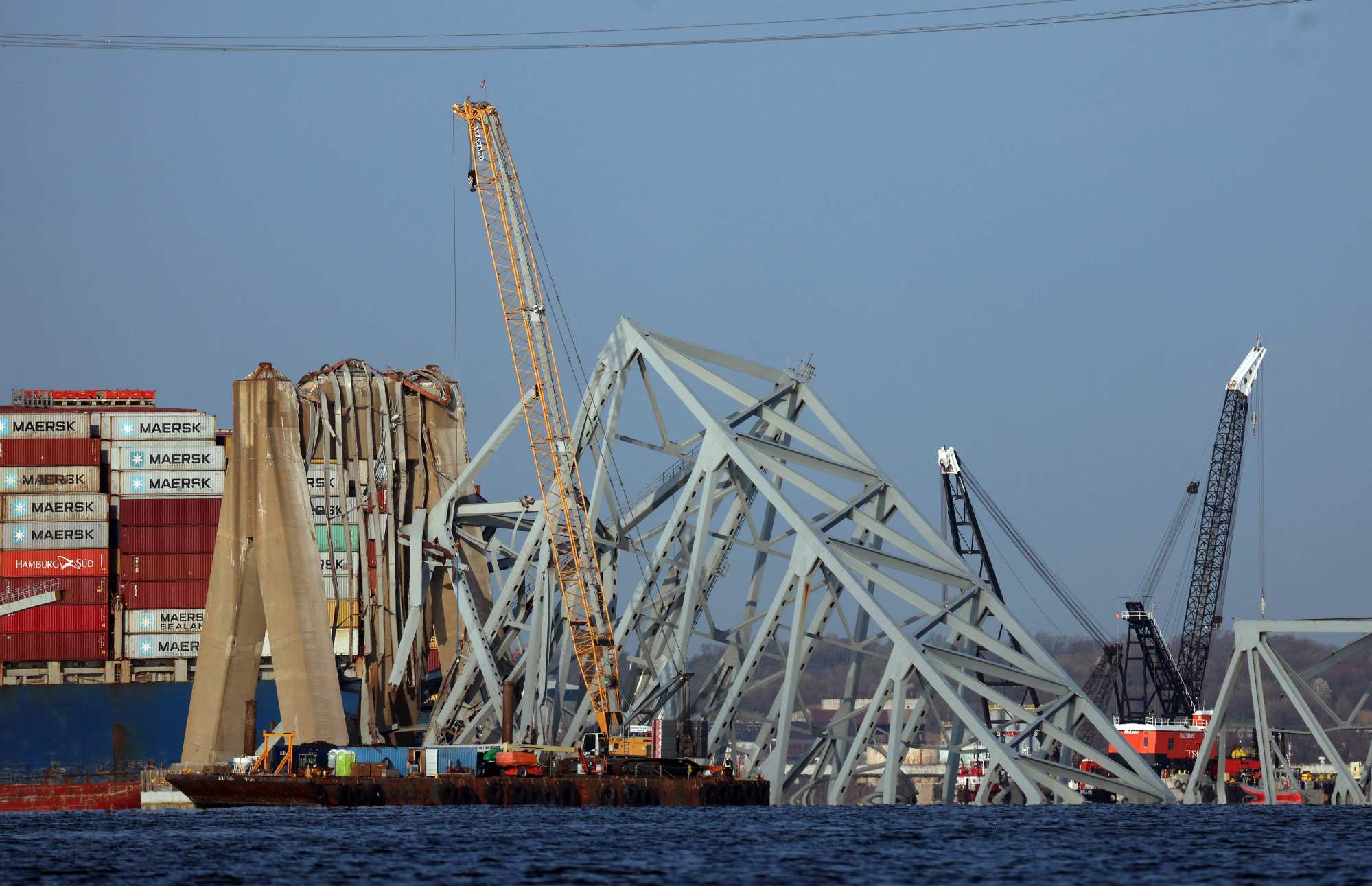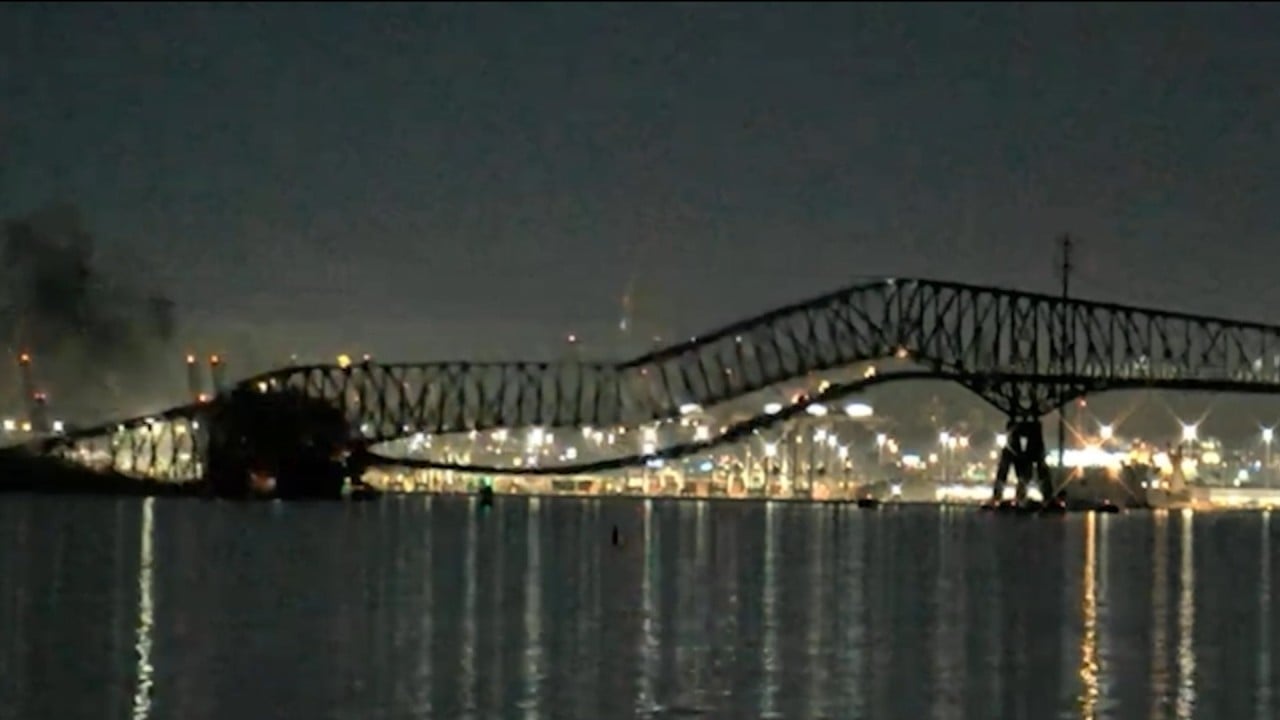
Explainer | The Baltimore bridge collapse and its impact on global trade
- Blocking passage into and out of the Port of Baltimore, the wreckage is shutting down ninth largest harbour in the US, a vital link to both Southeast Asia and China
- China was Baltimore’s No 2 import and No 3 export destination in 2023, and a leading consumer of coal shipped through the port
Three days after the Francis Scott Key Bridge crossing the Port of Baltimore was struck by a container ship and collapsed, killing six, officials have turned to restoring the vital shipping lane that is now unpassable with debris.
Early on Tuesday, the 984-foot (300-metre) Dali lost power and diverged from the standard path before crashing into one of the bridge’s pillars. Though traffic had been stopped on the bridge after the crew transmitted a distress signal, six construction workers and their vehicle plunged into the river.
Bodies of two of the six have been recovered. Search for others was halted on Thursday as the debris made it dangerous for divers to continue. The ship also has some containers with hazardous material.
All 22 crew members, almost all from India, have remained aboard the vessel and have been questioned by a team of the National Transportation Safety Board. Investigators have obtained the ship’s data recorder and so far ruled out foul play.
Clean-up and rebuild
The US government has announced US$60 million in emergency relief aid for early recovery and clean-up.
President Joe Biden has pledged to fund the rebuilding of the 47-year-old bridge that handled 11.3 million crossings annually. It is expected to take more than a year to construct a new bridge.
On Friday, a 1,000-ton (907-tonne) crane, the largest on the east coast, arrived on the disaster scene to help clear the waterway. Federal and state authorities say it remains unclear how long it could take to resume cargo traffic.
The twisted wreckage of the 2.6km (1.6 miles) bridge – pieces of which are still wrapped around the Dali, which carried 4,700 cargo containers – is blocking freighters from sailing the only channel that connects the port to the Atlantic Ocean.
Central American and Mexican families mourn missing workers in Baltimore
Supply chain threat
That’s bad news for global supply chains as east coast ports in the US have become more significant in recent years with Washington’s push for “friendshoring”.
US east coast ports have been gaining market share of both total and Asian imports compared to Pacific ports – a result of factors like the pandemic and trade wars, but also supply chain issues like congestion, infrastructure expansion and efficiency.
The US has been boosting its trade with so-called friendly countries while trying to diversify away from China amid geopolitical tensions.
More trade with China is done via US west coast ports while shipments to and from South Asian countries like Vietnam, Malaysia, India, Bangladesh often use the east coast ports despite their farther distance. Indeed, the Dali, registered in Singapore, was bound for Sri Lanka.

Because of the collapse, cargo headed to Baltimore will be rerouted to other US ports, with logistical disruptions and capacity issues likely.
There may also be some impact for China, which – even with its use of west coast ports – was Baltimore’s No 2 import and No 3 export trading partner in 2023, measured by tonnage.
“Locally, shippers dependent on Baltimore will face the challenge of urgently finding alternatives and will also likely incur higher costs for arrangements farther away from their desired hub”, said Judah Levine of Freightos, a booking and payments platform for international freight companies.
Baltimore bridge collapse may trigger historic multibillion-dollar insurance loss
Port’s featured cargo
Until Tuesday, the Port of Baltimore was the ninth largest US harbour, by tonnage and dollar value of foreign cargo.
Last year, the port handled 52.3 million tons of foreign cargo worth nearly US$81 billion. Carmakers including Mazda, Mercedes-Benz and Subaru are major users; the port handled a record 750,000 cars and light trucks last year – the most for any American port.
Last year, it was also the second busiest for coal exports, accounting for 28 per cent of total US coal exports in 2023. Shipments of fuel oils, natural gas, and other fossil fuel products also move through.
In 2021, the top five export destinations for US coal were, in descending rank, India, China, Japan, the Netherlands, and South Korea, according to the US Energy Information Administration. In 2023, China remained one of the key consumers of US thermal coal.
Now, coal shipments will have to be rerouted to other east coast ports – New York-New Jersey; Philadelphia; Wilmington, Delaware; and Norfolk, Virginia – while any shortage could be made up by countries like Indonesia and Australia.
Baltimore also ranked first in the US in handling farm and heavy construction machinery, as well as agricultural equipment, fertiliser, and many other agriculture-related products.
US denounces China for filing WTO complaint over EV subsidies
The port’s top five agricultural products are sugar, soybeans, corn, wheat and coffee. Most of the soybean exports are destined for Asia.
About 50 per cent of US soybeans are consumed by China. But prices of soybeans are unlikely to rise because other US ports also move the commodity.
Other items the port handled in 2022 included imports of more than 106,000 tons of furniture, 83,000 tons of meat and seafood. Imports of plastics and rubber totalled more than 221,000 tons that year.

Mounting losses
Emphasising the importance of the port to international trade, Governor Wes Moore of Maryland described the collapse as a “global crisis”. As the broken bridge lies in the Patapsco River, nearly 15,000 jobs are at risk if the shutdown runs into months.
The port, which is facing business losses of roughly US$50 million a day according to one estimate, indirectly supports another 140,000 roles in hospitality and other industries.
According to the US Department of Transportation, 10 vessels are now stuck inside the port of Baltimore.
In the coming weeks, chemical tank ships, five container ships, 15 vehicle carriers and 13 bulk carriers were expected to arrive at the facility. All those will be diverted to other ports depending on their capacity to take additional cargo.


